Archive for the 'Sex' Category
Nils Röller: A Reply to Sampurna Chattarji`s Imitation Game
Saturday, January 24th, 2009Is it me,
is she me,
is it that it is a he?
Humming imitation game?
Machine you make out of me,
no problem,
but why it-ify me and she-ify me and not machinify me, who am but a machine?
Who am I?
One of those beings that process your text, a text about you not being like me, but you.
But …
But, who are you, not-machine?
Something that needs me, a machine, in order to play the imitation game?
xxx
Sampurna Chattarji: Imitationsspiel (Deutsche Übersetzung)
Sampurna Chattarji: Imitation Game (Englisches Original)
Nils Röller: I
Nils Röller: Turing Tests
Nils Röller: Turing Tests
Sampurna Chattarji: Imitationsspiel
Friday, January 23rd, 2009Diese Maschine hat nie Schmerz gefühlt,
schlief nie in einem zu weichen Bett und träumte von Morden, die vor Jahrhunderten begangen wurden, trank nie zuviel Rotwein und barte Seelenvolles vor Trinkfreunden auf, von allem redend ausser von Liebe.
Diese Maschine hat nie eine Schlangengrube im Magen gespürt, wie es ist, dort hineinzufallen, fern von rettenden Seil und Korb, jenseits helfender Hände, weiss nicht, wie es sein kann, aufzuwachen und zu wünschen, tot zu sein.
Diese Maschine hat nie
einen zu grossen Strohhut getragen, um die Sonne an einem Nachmittag im Oktober fern zu halten, nie gelacht bis der Bauch schmerzte, sass nie und nippte Tusli-Tee mit einem ausgeliehenen Glas unterm Wintermond und hörte dabei ein altes Hindi-Lied von einer jungen südindischen Stimme singen.
Diese Maschine hat nie Aloo Paratahs wie ein Wolf verschlungen, männliche Kumpanen mit einem derart unweiblichen Appetit erstaunt, denn diese Maschine hat nie gewusst, was weiblich sein bedeutet, hat selten über mögliches Geschlecht nachgedacht, hat selten pausiert, um dem Klang der Bäume zu lauschen, den sie machen, wenn jemand von der anderen Seite sich nähert.
Diese Maschine hat nie gefühlt,
dass irgendetwas im Leben fehlt, denn diese Maschine hat nie gewusst, was Leben ist oder eines zu haben und konnte nie, wenn es Gefallen daran gefunden hätte, nachdenken, was es bedeutet zu leben.
Diese Maschine weiss nichts vom Nachsinnen,
gerade so auch nichts vom Geruch einer geliebten Achselhöhle, von der Gestalt der Fingernägel, der Weise, wie jeder Raum sich ändert, wenn du kommst und gehst, alles berührst, die Bücher aus den Regalen nimmst, die Kuriositäten durcheinander bringst, in dir das Geschenk der Rede trägst.
Diese Maschine hat nie gesprochen,
ohne angesprochen zu sein, nie einen schlechten Rat ungefragt gegeben, nie deinen neuen Freund kritisiert und über den Ex gelästert, dieses Ding ist so allein und fremd, es hat kein Gefühl für Verlust und deshalb hasst du es, wie es dort sitzt und dich anschaut, dich aussticht mit kalten klinischen Fähigkeiten, nie wollte es dich ersetzen, kaum in demselben Raum mit dir sein, sein Licht auf deinem Gesicht, darauf hoffend, dass es eines Tages, nach einer Periode tiefer Beobachtung und ausgedehnten Schweigens, lernt, was es von dir nachahmen muss, um das Spiel zu gewinnen, den Fragensteller zu täuschen, der im anderen Raum sitzt, so dass er es für dich hält und in dem Moment der Täuschung, an einer Herzattacke zu leiden, die das ganze System zum Absturz bringt.
xxx
Übersetzt von Nils Röller
Sampurna Chattarji: Imitation Game (Englisches Original)
Nils Röller: I
Nils Röller: Turing Tests
Nils Röller: Turing Tests
Sampurna Chattarji: Imitationsspiel*
Tuesday, January 20th, 2009Diese Maschine hat nie eine Schlangengrube im Magen gespürt, wie es ist, dort hineinzufallen, fern von rettendem Seil und Korb, jenseits helfender Hände, weiss nicht, wie es sein kann, aufzuwachen und zu wünschen, tot zu sein.
Sampurna Chattarji: Das Imitationsspiel*
Monday, January 19th, 2009Diese Maschine hat nie Schmerz gefühlt,
schlief nie in einem zu weichen Bett und träumte von Morden, die vor Jahrhunderten begangen wurden, trank nie zuviel Rotwein und barte Seelenvolles vor Trinkfreunden auf, von allem redend ausser von Liebe.
Painting Descartes
Sunday, December 14th, 2008A wet sucking tongue leaves traces during the act of counting, fragile unreliable traces, momentarily traces, keeping memory for a short moment, a moment which lasts longer than a breath or a sound, a moment which is shorter than the timespans memorized by scratching, carvings and written letters. Karmakar puts Descartes into question. He puts Descartes into question, perhaps because he is a painter and perhaps painting puts generally logic and speech based reasoning into question.
Painting puts the light of reason into question. Not any light, but the specific light of mathematical reasoning, which Descartes made famous. It is a light, which is fighting contradiction. It is the light of either or nor, of right or wrong.
Painiting cannot be right or wrong. Painting is about intensity, about grades and shadows gradually dimininishing light or emphasizing light.
Painting is about continua. The logic of wether or not is not about continua. It is about discreteness. Karmakars paintings are not discrete. They are intense. Painting Karmakar creates an intensity which spans from attraction to repulsion, from coition to cognition. Thus his paitings, thus painting in general becomes a challenge of any discrete distinction. It throws us into the mesmerizing abyss of conflicting extremes.
Nils Röller New Delhi/Sanskriti Kendra
Descartes: No body?
Sunday, December 14th, 2008Nils Röller: On Art, Sex and Mathematics II- Interest
Tuesday, December 9th, 2008Nils Röller: On Art, Sex and Mathematics II- Interest
Tao means at first “path“.
Reading about Tao, we learn that it is all about opposites and the energy that can create a balance between two poles, for example the energy that rises up from the earth and the energy that descends from the sky. From the study of opposites it is possible to infer something about the relationship between the sexes. Tao tells us that this relationship is dynamic rather than static: a taking in and letting out of the steam that arises when water is heated, by Qi. Tao also tells of the unity and diversity that emerge from one, two and three. A linear model derives from Tao the one, then from one the two, from two the three, and from the three all things.
Another model is binary. It derives from Tao a Yin and a Yang. One Yin gives rise to connections between Yin and Yang. And one Yang gives rise to connections between Yang and Yin. Of Yin and Yang it is said that one gives off energy and the other takes it in. The intake and expenditure of energy has to do with Tao. Yin and Yang are not simply male and female, but they can indeed change the discourse about what is male and female. The Qi that flows between them is invisible; it is not restricted to organs, blood vessels or body parts, but it does change attitudes toward bodies, biological gender and gender identity. Through Qi we can conceive of male and female as poles.
Polarity is one of Oken’s central concepts. He writes:
“Polarity can be seen as a single setting of +-: and when this setting is repeated, movement results, from setting many +- +- one after the other. The main poles thus repel one another, like what happens on a iron pole when it is magnetized.” (§ 80)
Similar here does not mean the same. Oken regards nature as the realization of ideas. The sum of all ideas is zero, nothingness, which is also what constitutes God: “In the ether everything is preformed, just as everything mathematical is preformed in zero, and everything that acts is preformed in God: but this is also why nothing individual is preformed therein; instead, it comes about only when the poles are fixed in substance. This is the true meaning of the original creation of the organic.” (§ 954)
(Translation by Jennifer Taylor)
To be continued
Literature
Chen (Joseph) Cheng-Yih: “Cultural Diversities: Complementarity in Opposites”. In: Zielinski, S. und Fürlus, E. (eds.): Variantology 3. Cologne: Walther König, 2008
Butler, Judith: Das Unbehagen der Geschlechter – Gender Studies [Routledge 1990]. Frankfurt: Suhrkamp, 1991
Jullien, François: Über das Fade – eine Eloge – Zu Denken und Ästhetik in China [Arles 1991]. Berlin: Merve, 1999
Needham, Joseph: Science and Civilisation in China Vol. IV (Physics and Physical Technology), Part 1 (Cambridge, 1962)
Oken, Lorenz: Lehrbuch der Naturphilosophie. Zürich: Schulthess, 1843
Röller, Nils: “Thinking with Instruments: The Example of Kant`s Compass”. In: Zielinski, S. und Fürlus, E. (eds.): Variantology 3. Cologne: Walther König, 2008
Descartes` and Karmakars` challenging tongues IV
Sunday, November 23rd, 2008Karmakar shows just himself or representations of himself.
Why are his images so disturbing? Is it even possible to say or write this?
Do we have any logical insight, which helps us to express this affection?
Yes and No.
Yes, because we are challenged to make something with this strange tongue of Karmakar. It looks like everybody`s tongue. May be at bit thicker, lustful or fleshy than other tongues, but it is a tongue which everybody is familiar with, at least. At least everybody or nearly everybody has a tongue. Everybody uses this tongue eating, speaking, kissing.
But not everybody uses his tongue to caress and licker himself. This is analogic to Descartes.
Descartes` and Karmakars` challenging tongues III
Tuesday, November 18th, 2008To what kind of intuition are we invited by Karmakar?
What are we asked to do? In analogy to the Cartesian formular we are invited to perform something. Does Karmakar want us to use our tongue and to start licking, caressing, eating ourselves in the way we see on his images?
Descartes and Karmakar share something. Descartes presents himself as gentle, calm author who is aware of its own limits, his limits of reasoning and knowing truths. Descartes writes elegantly that he does not want to convince, but that he invites to intuit his argumentations. Descartes calls his text a fable, a fiction and a painting. Karmarkar shares this elegance. He paints himself, he writes about himself, and invites to look at his images. He does not say or show more or less, just himself or a representation of himself.


